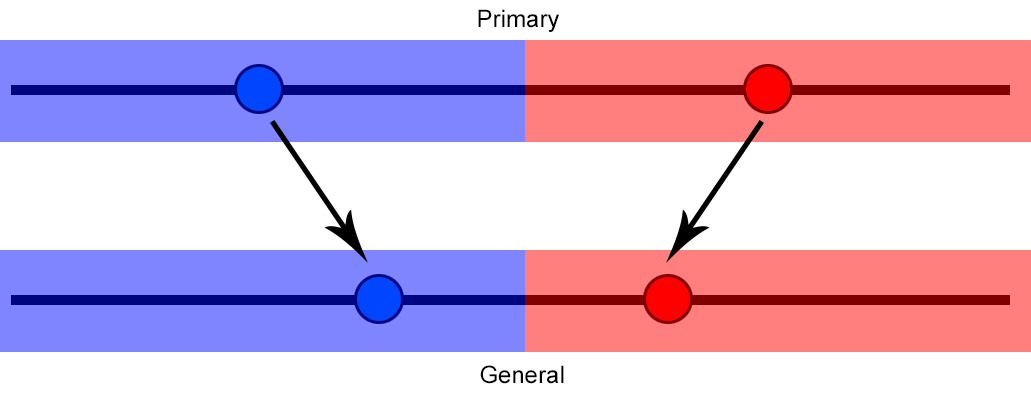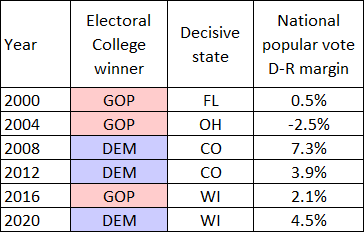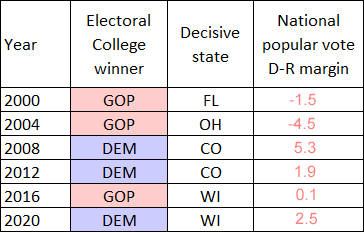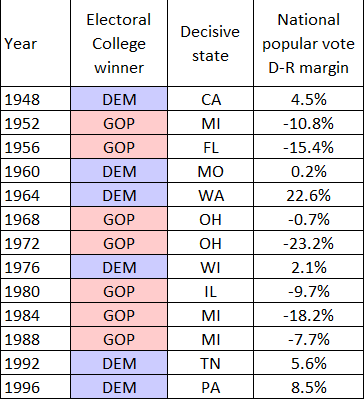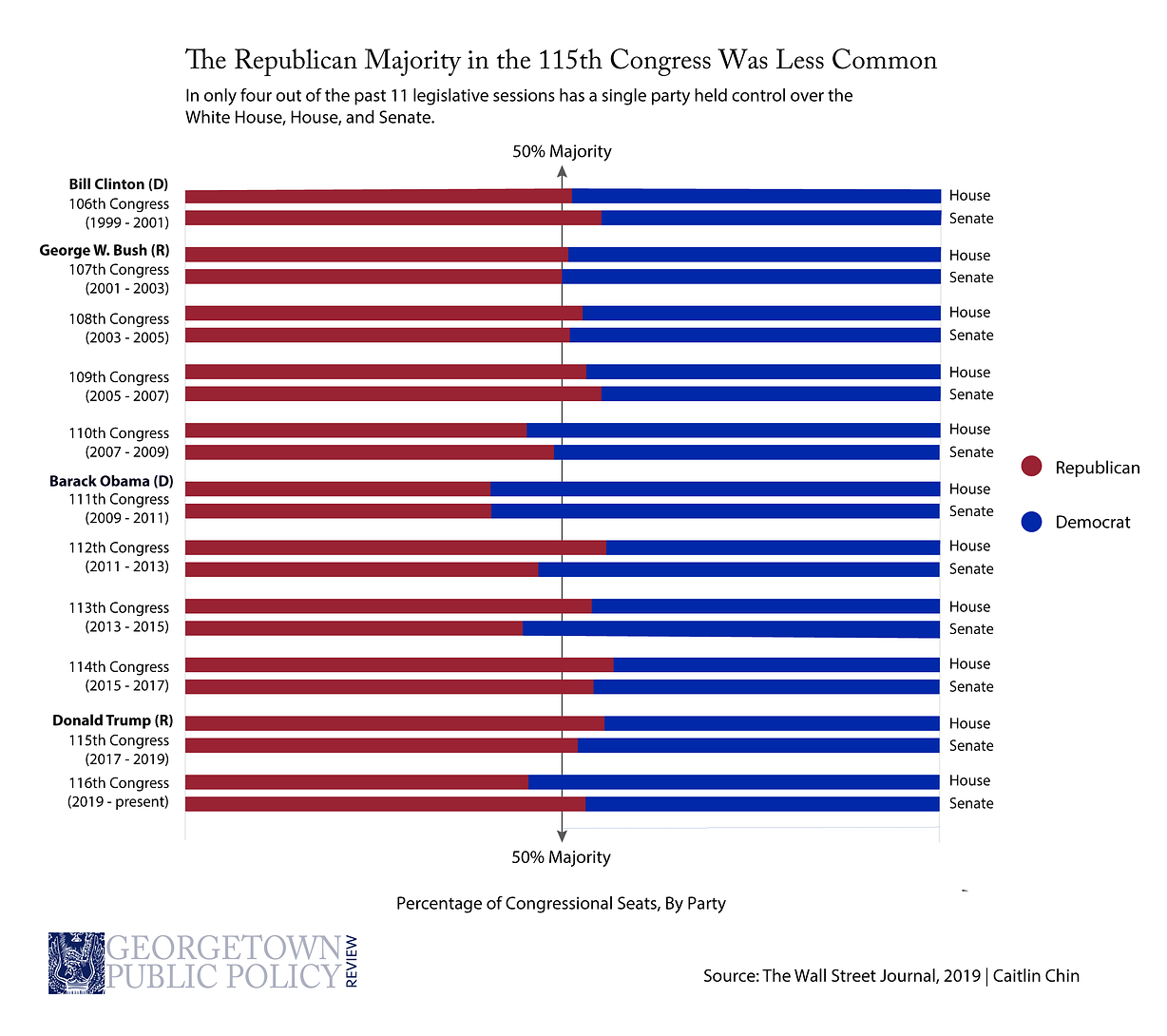Astral Codex Ten - Secrets Of The Median Voter Theorem
[ES: I am not a political scientist. I’ve tried to find good political science on these topics and failed; maybe you can point me in the right direction] The Median Voter Theorem says that, given some reasonable assumptions, the candidate closest to the beliefs of the median voter will win. So if candidates are rational, they’ll all end up at the same place on a one-dimensional political spectrum: the exact center. Here’s a simple argument for why this should be true: suppose the Democrats wisely choose a centrist platform, but the Republicans foolishly veer far-right: Now suppose that every voter (represented as a point on this line from furthest-left to furthest-right) reasonably chooses the candidate closest to their own position: The Democrats get most of the vote and win easily. Here the Republicans’ best strategy is obvious: shift to the middle. Now it’s 50-50 again and both sides have an even chance of winning. The real median voter theorem is much more complicated than this, and can handle arbitrary numbers of candidates and complex voting methods. But this argument is good enough for now. Elegant as this proof may be, it completely fails to describe the real world. Democrats and Republicans don’t have platforms exactly identical to each other and to the exact most centrist American. Instead, Democrats are often pretty far left, and Republicans pretty far right. What’s going on? I think at least three things. First, candidates have to win a primary. In order to win the Democratic primary, the Median Voter theorem says you should match the belief of the median Democratic primary voter. But then you get to the general election and you’re in the wrong place! You might like to veer towards the middle after winning the primary. But then your opponent will run attack ads saying “So-and-so promised to defund the police in the primary; now she’s saying we need more cops on the streets. Obviously she’s an untrustworthy flip-flopper talking out of both sides of her mouth!” Also, if you’re the sort of person who would immediately betray your base after winning, they’ll notice and won’t vote for you. So in real life, the veer towards the middle is limited and subtle. At most, a candidate might try saying vaguely anti-police things during the primary and vaguely pro-police things in the general, then hope they were vague enough not to have explicitly lied. Second, people don’t have to vote. The extreme-far-left probably won’t vote for a Republican. But they might stay home. In fact, if both candidates were exactly equal in the exact middle of the distribution, why wouldn’t they stay home? Here’s a centrist Democrat’s nightmare scenario: As per the Median Voter Theorem, most people prefer the (centrist) Democrat to the (more extreme) Republican. But the far left doesn’t care enough to vote, so the Republicans carry the day. Extremists love thinking about this scenario, because it means candidates should pander to them more. But political scientists have looked into this and found that it almost never happens in real life. It’s rare for a competently-executed veer towards the center to lose you more votes (through low turnout of the base) than it gains you (by convincing swing voters). Every year, extremists urge their candidates to try this stupid and doomed strategy; every year, a few candidates fall for it and lose. Still, maybe something like this could happen in the unrealistic scenario where both candidates take the Median Voter Theorem literally and stay in the exact indistinguishable center of the spectrum. Also, even if this never works for voters, it might work for donors and volunteers, who tend to be more extreme than the rank-and-file. A candidate who veers to the exact center might find their funds drying up, or their supply of door-knockers anomalously low. Third, parties exist because they want something. Maybe the Democrats want more school funding. Their base are parents who care a lot about this; their donors are teachers unions; their candidate is a former school superintendent who got into politics because she believes deeply in this. Maybe everyone involved is willing to accept a 10% decrease in their chance of winning in order to get this. This suggests the possibility of “collusion” between Democrats and Republicans. The Democrats want more school funding. The Republicans want something else, let’s say more military funding. The median voter wants neither of these things. But it seems like the Democrats and Republicans can “collude” against the median voter by both proposing extreme policies. If neither party pursued their unpopular goal, they would each have a 50% chance of winning. If both parties pursue their unpopular goal, they still each have a 50% chance of winning. So if the parties trust each other, they can cooperate by both pursuing their respective unpopular goals, and each get more of what they want. This seems to throw the whole Median Voter Theorem out the window: how should we know whether to expect both parties at the exact center (no collusion) or both parties at the furthest possible extreme (maximum collusion)? Either way, they keep the same 50% chance of winning! I don’t understand this part very well, but I think the answer must be that the parties don’t literally collude in smoke-filled rooms. They always worry a little about the other party veering towards the center, and base their own movements on reaction and tradition. If the other party selects an extreme candidate, they’ll split the difference, taking some of the windfall as increased chance of victory but spending some of it on become more extreme themselves. And they’ll overall assume that the other party will be about as extreme as it was in past elections, and that they have license to be extreme enough to counterbalance that. II. I said above that the real world doesn’t follow the Median Voter Theorem. But is that true? Certainly both parties don’t have indistinguishable and perfectly centrist platforms. But here are the last twenty years of election margins of victory (source): The average margin of victory was 3.5%. But the GOP has about a two percentage point Electoral College advantage; that is, the popular vote total most likely to produce an electoral tie is one where the Democrats lead by 2. Adjust for this advantage (we’ll talk later about whether we should), and it looks like this: Now the average margin of victory is only 2.6%. Isn’t this weird? In a world with so many numbers - 55-to-45, 80-to-20, 99-to-1 - all of the past three elections have been approximately 49-51. So maybe the Median Voter Theorem does work. Here we would have to go back to the collusion theory again. The parties don’t necessarily stay near the center. But they do put a lot of work into making sure they’re exactly the same distance from the center as each other. Counterargument: this can’t be an iron law of politics, because even forty years ago it wasn’t true. Here’s a part of the graph above that I left out: In 1964, LBJ beat Goldwater 61-39. In 1972, Nixon beat McGovern 61-37. Even as recently as 1984, Reagan beat Mondale 59-41. But we already know that partisanship was weaker in those days. The Median Voter Theorem only works if you can reduce everything to a single straight line. If voters don’t care about the right-left spectrum, they might judge based on criteria like “Reagan is more charismatic”, and then if everyone agrees that he’s charismatic you can get 59-41 or 90-10 or whatever numbers you want. In the old days, partisanship was too weak for the Median Voter Theorem to hold. Now it’s strong enough to matter, but there’s enough primary effect and “collusion” that parties don’t race towards the center, instead only trying to maintain equal distance from the center. But we may still find this surprising. The parties - especially the Republican Party - don’t feel like masterminds executing a complicated dance where they determine the exact amount of extremism the voters can tolerate. And what about non-partisan factors? Do they figure in? If some people dislike Trump because he committed 10,000 felonies and an attempted coup, do the Democrats enter that into their calculations and veer slightly further left? If Biden is demented, do the Republicans enter that into their calculations and veer slightly further right? If so, how come when Biden was replaced with the less-demented Kamala and the Democrats’ betting odds went way up, Trump didn’t change any of his positions AFAICT? The stats show that the past few elections, adjusted for electoral vote advantage, have all been around 49-51. But it doesn’t seem like the parties are working as hard as they would have to be to do it on purpose. Is it just a coincidence? Is there some deeper thermostat independent of the platforms and candidates of the moment? I’m not sure. But I do think we can say with confidence that the reason elections are almost never 80-20 or 99-1 is something like Median Voter Theorem. III. Okay, so the parties have to be in the middle. But which part of the parties? In the middle of what? Do parties target the median popular voter, or the median electoral voter? It must be the latter. We saw above that elections get closer, rather than further, from 50-50 after you adjust for the GOP electoral advantage. Also, this is obviously what you would do if you were at all sensible. You even see evidence of parties doing this; for example, lots of people talk about how the “tipping point state” for this election is Pennsylvania, so both candidates are investing lots of resources there. That’s classic Median Voter Theorem! Here’s a harder question. If you want to control the Presidency, you should target the median electoral voter. If you want to control the House of Representatives, then to a first approximation you should target the median popular voter, since House Districts mostly reflect population. If you want to control the Senate, you should target a different median voter entirely, since the Senate gives small states even more of an advantage than the Electoral College does. Parties want to control all three of these things, so who should they target? Ideally, Presidential candidates would target the median Presidential voter, Senate candidates the median Senate voter, etc. But it may not be this easy. Voters may work off a gestalt impression of where “the party” stands. In theory, the Republican candidate for Governor in California could appeal to the median Californian; in practice, Republicans almost never win in California because Californians hate the national Republican Party. So parties may have to target one of these goals to the exclusion of the others. There’s rarely a united House/Senate platform (Gingrich’s Contract With America possibly excepted). So probably both parties target the Presidency. If we assume small states tend conservative, then the median House voter should be further left, and the median Senate voter further right, than the median Presidential voter. If parties have to run a unified platform, and they optimize this platform to win the Presidency, we should expect to see Democrats win the House and Republicans win the Senate more often than chance. Is this right? Add on the two recent Congresses not shown, and since the Clinton era, Democrats have controlled 4/13 Houses and 6/13 Senates, the opposite of my prediction. I think there’s not enough data for this to mean anything, and continue to think there might be a slight inherent Median Voter Theorem fueled tendency for Democrats to win the House (possibly counterbalanced by other things like who has gerrymandered more successfully). IV. Suppose something happens to give one party an advantage. Maybe DC, Puerto Rico, and Guam all become states, giving the Democrats six extra guaranteed Senators and some extra electoral votes. Which of these do we expect:
The common-sense answer is that it would take a while, there would be a lot of negotiation, but five or ten or thirty years later the Republicans would get their act together, shift left, and start winning elections again. The common-sense answer is probably right, but one thing still bothers me: how did the Republicans keep losing both houses of Congress every year from 1955 to 1981? Wouldn’t they have shifted left during this time? I don’t know, this was before our current partisan era, and there were lots of weird deals around civil rights going on. The parties had realigned enough that Southern Democrats were conservative while northern Democrats were at least kind of liberal, so I think Southern conservatives consistently voted for Democratic representatives even while sometimes voting for Republican presidents. If we accept the theory above that parties only optimize for presidential platforms and not Congressional ones, then since Republicans were still winning 50% of presidencies, they might not have felt like they had to change their platform. Or can parties just implode sometimes? I wouldn’t want to be the guy in the Republican primary who says “actually we Republicans should veer left”. Doesn’t feel like the kind of thing that would get lots of votes. Maybe after decades of humiliation and failure you could convince someone, but I don’t see the history of parties suffering decades of humiliation and failure before finally agreeing to turn around. Parties and candidates seem to do a suspiciously good job staying equidistant from the median voter, far beyond the pathetic amount of effort they explicitly put in. I still can’t tell if it’s all coincidence, or whether there are deeper currents at work. You're currently a free subscriber to Astral Codex Ten. For the full experience, upgrade your subscription. |
Older messages
ACX Local Voting Guides
Tuesday, October 22, 2024
... ͏ ͏ ͏ ͏ ͏ ͏ ͏ ͏ ͏ ͏ ͏ ͏ ͏ ͏ ͏ ͏ ͏ ͏ ͏ ͏ ͏ ͏ ͏ ͏ ͏ ͏ ͏ ͏ ͏ ͏ ͏ ͏ ͏ ͏ ͏ ͏ ͏ ͏ ͏ ͏ ͏ ͏ ͏ ͏ ͏ ͏ ͏ ͏ ͏ ͏ ͏ ͏ ͏ ͏ ͏ ͏ ͏ ͏ ͏ ͏ ͏ ͏ ͏ ͏ ͏ ͏ ͏ ͏ ͏ ͏ ͏ ͏ ͏ ͏ ͏ ͏ ͏ ͏ ͏ ͏ ͏ ͏ ͏ ͏ ͏ ͏ ͏ ͏ ͏ ͏ ͏ ͏ ͏ ͏ ͏ ͏ ͏ ͏ ͏
Open Thread 352
Monday, October 21, 2024
... ͏ ͏ ͏ ͏ ͏ ͏ ͏ ͏ ͏ ͏ ͏ ͏ ͏ ͏ ͏ ͏ ͏ ͏ ͏ ͏ ͏ ͏ ͏ ͏ ͏ ͏ ͏ ͏ ͏ ͏ ͏ ͏ ͏ ͏ ͏ ͏ ͏ ͏ ͏ ͏ ͏ ͏ ͏ ͏ ͏ ͏ ͏ ͏ ͏ ͏ ͏ ͏ ͏ ͏ ͏ ͏ ͏ ͏ ͏ ͏ ͏ ͏ ͏ ͏ ͏ ͏ ͏ ͏ ͏ ͏ ͏ ͏ ͏ ͏ ͏ ͏ ͏ ͏ ͏ ͏ ͏ ͏ ͏ ͏ ͏ ͏ ͏ ͏ ͏ ͏ ͏ ͏ ͏ ͏ ͏ ͏ ͏ ͏ ͏
Open Thread 351
Sunday, October 20, 2024
... ͏ ͏ ͏ ͏ ͏ ͏ ͏ ͏ ͏ ͏ ͏ ͏ ͏ ͏ ͏ ͏ ͏ ͏ ͏ ͏ ͏ ͏ ͏ ͏ ͏ ͏ ͏ ͏ ͏ ͏ ͏ ͏ ͏ ͏ ͏ ͏ ͏ ͏ ͏ ͏ ͏ ͏ ͏ ͏ ͏ ͏ ͏ ͏ ͏ ͏ ͏ ͏ ͏ ͏ ͏ ͏ ͏ ͏ ͏ ͏ ͏ ͏ ͏ ͏ ͏ ͏ ͏ ͏ ͏ ͏ ͏ ͏ ͏ ͏ ͏ ͏ ͏ ͏ ͏ ͏ ͏ ͏ ͏ ͏ ͏ ͏ ͏ ͏ ͏ ͏ ͏ ͏ ͏ ͏ ͏ ͏ ͏ ͏ ͏
AI Art Turing Test
Sunday, October 20, 2024
... ͏ ͏ ͏ ͏ ͏ ͏ ͏ ͏ ͏ ͏ ͏ ͏ ͏ ͏ ͏ ͏ ͏ ͏ ͏ ͏ ͏ ͏ ͏ ͏ ͏ ͏ ͏ ͏ ͏ ͏ ͏ ͏ ͏ ͏ ͏ ͏ ͏ ͏ ͏ ͏ ͏ ͏ ͏ ͏ ͏ ͏ ͏ ͏ ͏ ͏ ͏ ͏ ͏ ͏ ͏ ͏ ͏ ͏ ͏ ͏ ͏ ͏ ͏ ͏ ͏ ͏ ͏ ͏ ͏ ͏ ͏ ͏ ͏ ͏ ͏ ͏ ͏ ͏ ͏ ͏ ͏ ͏ ͏ ͏ ͏ ͏ ͏ ͏ ͏ ͏ ͏ ͏ ͏ ͏ ͏ ͏ ͏ ͏ ͏
Book Review: Deep Utopia
Sunday, October 20, 2024
What problem do we get after we've solved all other problems? ͏ ͏ ͏ ͏ ͏ ͏ ͏ ͏ ͏ ͏ ͏ ͏ ͏ ͏ ͏ ͏ ͏ ͏ ͏ ͏ ͏ ͏ ͏ ͏ ͏ ͏ ͏ ͏ ͏ ͏ ͏ ͏ ͏ ͏ ͏ ͏ ͏ ͏ ͏ ͏ ͏ ͏ ͏ ͏ ͏ ͏ ͏ ͏ ͏ ͏ ͏ ͏ ͏ ͏ ͏ ͏ ͏ ͏ ͏ ͏ ͏ ͏ ͏ ͏ ͏ ͏ ͏ ͏
You Might Also Like
It’s a great moment for startups — with one caveat | Microsoft retiring Skype
Friday, February 28, 2025
Meet the new leader of Alliance of Angels | Amazon commits $100M to Bellevue for housing ADVERTISEMENT GeekWire SPONSOR MESSAGE: SEA Airport Is Moving from Now to WOW!: Take a virtual tour of
S*M*A*S*H*
Friday, February 28, 2025
Measles and Maha, Putin's Pawn ͏ ͏ ͏ ͏ ͏ ͏ ͏ ͏ ͏ ͏ ͏ ͏ ͏ ͏ ͏ ͏ ͏ ͏ ͏ ͏ ͏ ͏ ͏ ͏ ͏ ͏ ͏ ͏ ͏ ͏ ͏ ͏ ͏ ͏ ͏ ͏ ͏ ͏ ͏ ͏ ͏ ͏ ͏ ͏ ͏ ͏ ͏ ͏ ͏ ͏ ͏ ͏ ͏ ͏ ͏ ͏ ͏ ͏ ͏ ͏ ͏ ͏ ͏ ͏ ͏ ͏ ͏ ͏ ͏ ͏ ͏ ͏ ͏ ͏ ͏ ͏ ͏ ͏ ͏ ͏ ͏ ͏ ͏
DOGE is operating in near-total secrecy. We’re about to break it wide open.
Friday, February 28, 2025
Under the Freedom of Information Act, the public has a right to access documents and other information that will shed light on DOGE's operations, and we're committed to getting to the truth.
TFGIF: ♻️ In Trumpland, it ain’t easy being green
Friday, February 28, 2025
The fight for the soul of the battery belt and the other C-word. Welcome to Lever Daily's TFGIF. Each Friday, we share one deep-dive Lever story and one deep-dive podcast episode full of original
☕ Wait and DTC
Friday, February 28, 2025
Bonobos's new ambitions. February 28, 2025 View Online | Sign Up Retail Brew Presented By Brookfield Properties Hi there. This week, Amazon dropped a new Alexa upgrade powered by (you guessed it)
Debunking some myths about Tangle (and me).
Friday, February 28, 2025
Let's talk about why we are here. Debunking some myths about Tangle (and me). Let's talk about why we are here. By Isaac Saul • 28 Feb 2025 View in browser View in browser Photo by Nijwam
Decisive Moments, Creative Playbooks and Who Is Really Watching TV?
Friday, February 28, 2025
10 stories that have given us creative inspiration this week
Everything-Except-Book Review Contest 2025
Friday, February 28, 2025
... ͏ ͏ ͏ ͏ ͏ ͏ ͏ ͏ ͏ ͏ ͏ ͏ ͏ ͏ ͏ ͏ ͏ ͏ ͏ ͏ ͏ ͏ ͏ ͏ ͏ ͏ ͏ ͏ ͏ ͏ ͏ ͏ ͏ ͏ ͏ ͏ ͏ ͏ ͏ ͏ ͏ ͏ ͏ ͏ ͏ ͏ ͏ ͏ ͏ ͏ ͏ ͏ ͏ ͏ ͏ ͏ ͏ ͏ ͏ ͏ ͏ ͏ ͏ ͏ ͏ ͏ ͏ ͏ ͏ ͏ ͏ ͏ ͏ ͏ ͏ ͏ ͏ ͏ ͏ ͏ ͏ ͏ ͏ ͏ ͏ ͏ ͏ ͏ ͏ ͏ ͏ ͏ ͏ ͏ ͏ ͏ ͏ ͏ ͏
GeekWire Startups Weekly
Friday, February 28, 2025
News, analysis, insights from the Pacific NW startup ecosystem View this email in your browser Presented by Seattle-Tacoma International Airport New head of Alliance of Angels excited to hit '
Tokyo Bayes
Friday, February 28, 2025
Writing of lasting value Tokyo Bayes By Caroline Crampton • 28 Feb 2025 View in browser View in browser 10 Observations About Tokyo Quico Toro | Persuasion | 19th February 2025 American resident in





